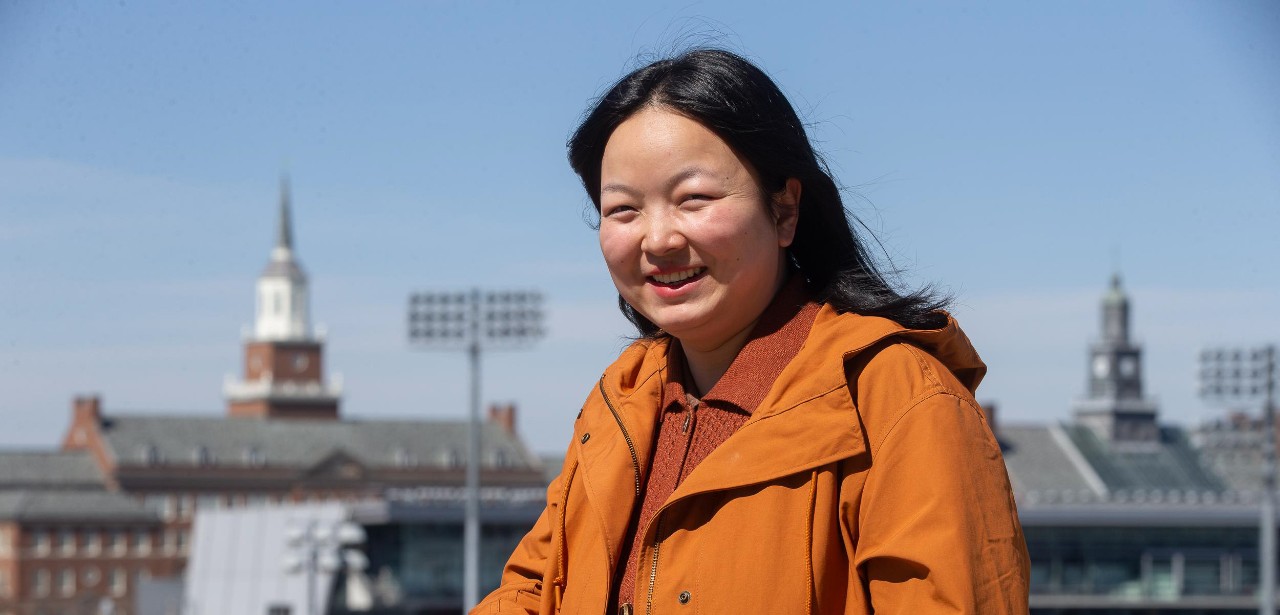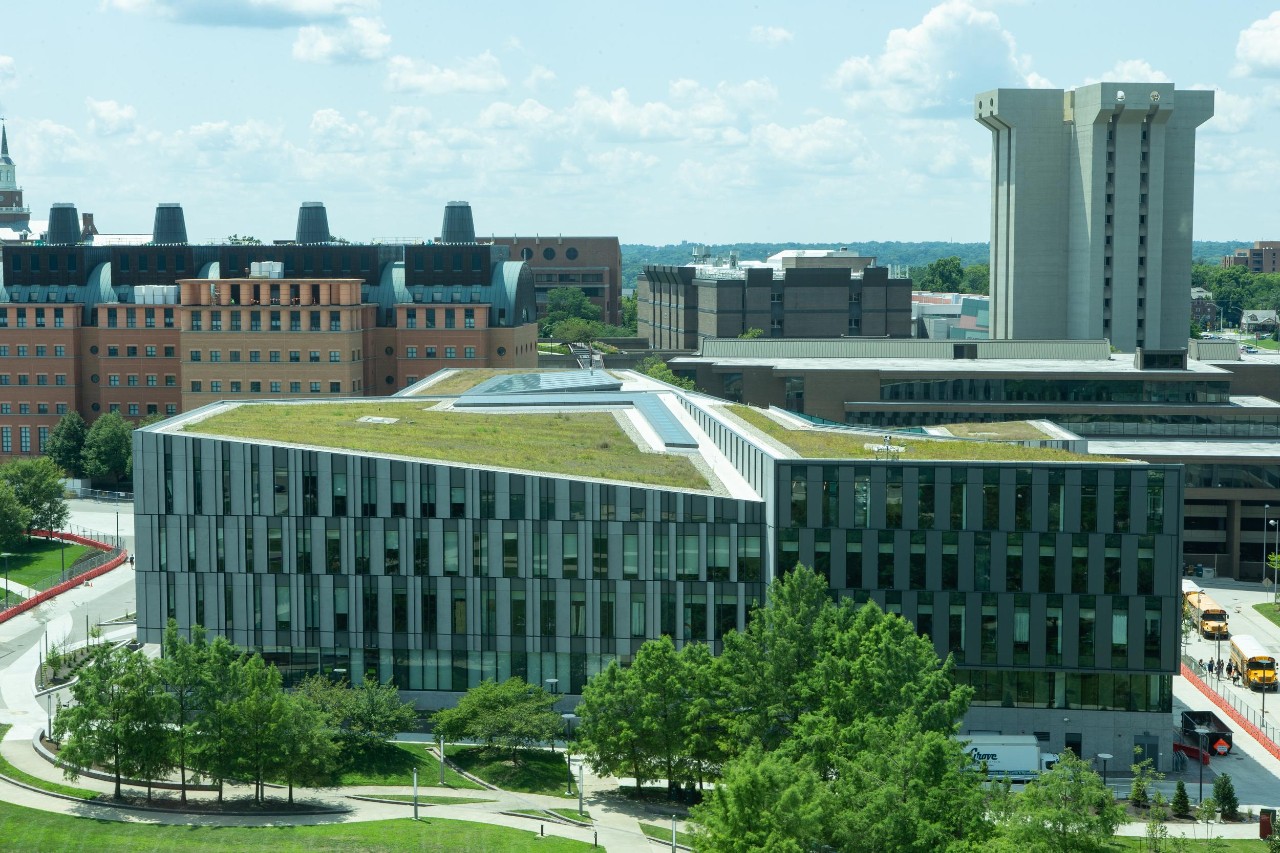
Focus turns to flood prevention in face of climate change
UC geography study finds detention basins often work best
Planners have come up with many innovative ways to prevent flooding caused by heavy downpours — from planting rain gardens to installing green roofs.
But in many cases, nothing works quite as well as a simple hole in the ground — a detention basin.
That’s the finding of an analysis by University of Cincinnati geography students in a research collaboration with the Hamilton County Conservation District.
Lead author and UC College of Arts and Sciences doctoral student Man Qi said cities are developing new ways to trap rainwater and direct it where it’s most wanted, especially during droughts. They call these low-impact development practices, which include innovations such as permeable pavement that allows rainwater to seep into the ground instead of diverting it elsewhere.

The Civic Garden Center of Greater Cincinnati features a green roof that helps collect rainwater. Photo/Andrew Higley/UC Marketing + Brand
Another innovation is a bioretention cell composed of ornamental or landscaping plants atop soil specially designed to drain quickly spread over a thick bed of gravel that does likewise. This soaks up large volumes of rain without creating standing pools of open water.
New commercial or housing developments typically must prevent rainwater from spilling out to other neighboring properties or roads. Hard surfaces like buildings and parking lots can’t absorb heavy rains so planners must collect or divert the water to prevent property damage.
“A detention pond is a common practice,” Qi said. “It temporarily stores the water and releases it into the air or the groundwater or nearby streams at a low rate to reduce the risk of flooding. It also provides some ecological benefits.”
Qi worked with the Hamilton County conservation district to measure the effectiveness of flood-prevention techniques such as detention basins and bioretention cells under five scenarios.

UC's Lindner College of Business features a green roof that collects rainwater on UC's uptown campus. Photo/Andrew Higley/UC Marketing + Brand
Qi presented their results at the annual American Association of Geographers’ conference in Denver.
“In residential areas where the impervious area is less than 40%, low-impact development practices are better. But if 70% or more of the ground surface is impervious, it’s best to put in detention basins,” Qi said. “The flood risk can be greatly reduced.”
Climate change is expected to increase both the frequency and severity of rainstorms, which means making deliberate plans for drainage will become even more important in cities, said Professor Lin Liu, a study co-author and co-director of UC’s Joint Center of GIS and Spatial Analysis.
My sister's family was badly affected by the flooding. It was very scary.
Man Qi, UC doctoral student
With their hard reflective surfaces, cities tend to trap heat, raising the ambient temperature by as much as 7 degrees during the day. This urban heat island effect can provide more energy for damaging storms, Liu said.
“Global warming and urban sprawl have contributed to extreme weather,” he said. “Coupled with the urban heat island effect many metropolitan cities have experienced more extreme precipitation events. As a result, urban flooding has become an increasing threat to the loss of human life and property damage in many cities around the globe.”
“You can see the extreme rainfalls happen more frequently,” Qi added. “Intense, heavy rains could inundate networks designed to prevent flooding and the capacity of drainage networks could fail because they simply can’t hold that much stormwater.”
The issue of urban flooding became real for Qi in 2021 when her sister’s home was inundated by floodwaters in China’s Zhengzhou City. More than 10 million people were affected by the disaster, which was one of the most severe floods in the city’s history. As much rain fell in a single day as the city sometimes sees in an entire year.
“My sister’s family was badly affected by the flooding. The water flooded their garage. Their cars were underwater,” she said. “It was very scary.”
The flood killed nearly 400 people and caused $10 billion in property damage.
Qi said flooding disproportionately affects lower-income residents who don’t have the resources to recover as quickly from a disaster.
Flood insurers create maps around these once-in-a-century disasters. But because of climate change, they are happening more frequently, Qi said.
“Floods affect roads and infrastructure and interrupt society,” Qi said. “Schools are closed. Businesses are closed. The impacts are widespread.”
Featured image at top: University of Cincinnati doctoral student Man Qi is studying ways to prevent flooding in cities. Photo/Andrew Higley/UC Marketing + Brand
Next Lives Here
The University of Cincinnati is leading public urban universities into a new era of innovation and impact. Our faculty, staff and students are saving lives, changing outcomes and bending the future in our city's direction. Next Lives Here.
Related Stories
We love ‘Lucy’ — the AI avatar redefining UC tech transfer
July 17, 2024
In a visionary leap at the University of Cincinnati, the marriage of artificial intelligence and interactive technology has birthed "Lucy," a Smarthelp AI avatar poised to revolutionize how regional industries engage with UC's tech transfer initiatives.
NIS program opens new horizons for international student
July 17, 2024
In his pursuit of physics and a taste for research, Akash Khanikor ventured from his hometown in India's Assam to the University of Cincinnati, drawn by the promise of hands-on exploration early in his undergraduate career as a NEXT Innovation Scholar.
Camp aims to empower children, teens who stutter
July 17, 2024
A one-week, evidence-based program for children and teens who stutter at the University of Cincinnati will teach kids to communicate effectively, advocate for themselves and develop confidence about their communication abilities. Camp Dream. Speak. Live., which is coming to Cincinnati for the first time July 22-26, began in 2014 at the University of Texas at Austin. The Arthur M. Blank Center for Stuttering Education and Research at UT expects to serve more than 2,000 children at camps across the United States, Africa, Asia and Europe this year.
UC archivist explores Troy’s invisible workers
July 17, 2024
UC Classics archivist Jeff Kramer examined the unheralded and largely uncredited role laborers played in the 1930s excavation at Troy in Turkey.
U.S. stroke survival is improving, but race still plays role
July 16, 2024
U.S. News & World Report, HealthDay and Real Health covered new research from the University of Cincinnati that found overall rates of long-term survival following stroke are improving, but Black individuals experience worse long-term outcomes compared to white individuals.
Presidential challenge to UC: Join Ride Cincinnati to fight cancer
July 16, 2024
UC President Neville Pinto has again challenged every UC college and unit to send at least one rider to the September 14 Ride Cincinnati event to help fundraise for cancer research and cancer care. UC students ride free. Signup by July 31 for free UC-branded cycling jersey.
Building potential
July 16, 2024
Unexpected advice led to a new area of interest and growth for Andrew Matthews, leading him to the University of Cincinnati’s College of Engineering and Applied Science, construction management and cooperative education experiences at Turner Construction.
Pediatric ICU rates linked to housing quality, income, education
July 16, 2024
Healio highlighted research led by the University of Cincinnati and Cincinnati Children's Hospital's Carlie Myers that found a link between pediatric ICU admission rates and housing quality, household income and education.
UC study: Long-term stroke survival improving, but racial disparities remain
July 15, 2024
New research from the University of Cincinnati published in the journal Neurology found long-term survival rates following acute ischemic strokes are improving, but Black individuals experience worse long-term outcomes compared to white individuals.
Exploring parallels between Biden, Reagan in second-term campaigns
July 15, 2024
UC Professor Brian Calfano explains to Spectrum News how President Reagan overcame criticism related to his age to win a second term.
